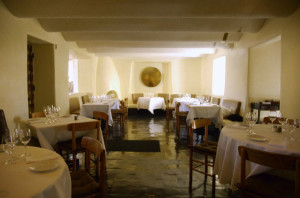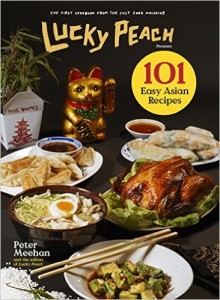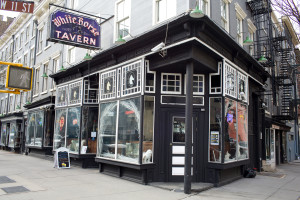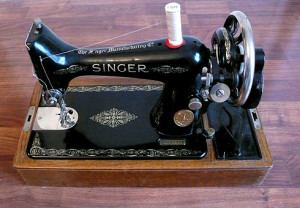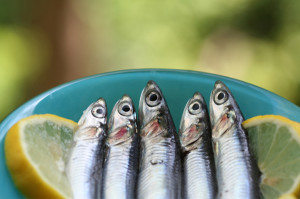One of the joys of HG/BSK’s years in the magical Canadian city of Vancouver was companionship with Jamie S., a charming young man who shared HG/BSK’s love of the good life. When Jamie was a neighbor (he in an extraordinary multi-level condo with a rooftop deck enhanced by skyscraper and mountain views; HG/BSK in an adjacent cutting edge steel and glass townhouse), Jamie was often HG/BSK’s Friday night at home dinner companion. BSK would prepare an extraordinary spatchcocked chicken or Berkshire pork chops. Jamie would bring wine and his selection was always flawless. In recent years, Jamie had the good luck to find an ideal partner, the very chic and graceful Karen. HG dined happily with Jamie and Karen during a visit to Vancouver last year (Karen prepared a very delicious and original meal at her home. Topped the very good meals we had in some new Vancouver restaurants). Good news this week. Jamie and Karen were in Phoenix for a business show and drove to New Mexico for a two day visit. Food highlight of the joyous reunion was dinner at Santa Fe’s Compound Restaurant. The quartet of gourmands decided upon a variety of small plates ordered from the bar menu. These were the dishes: Tuna tartare; Seared sea scallops with Brussels sprouts and crisp apple slices; Fettucine lobster carbonara; Wild mushrooms and stone ground polenta; Buttermilk fried onion rings; Butter sautéed Chantarelle mushrooms. Jamie selected a chilled Gruet sparkling wine and a flavorful Chianti. Desserts were olive oil cake and pear tart with lush house-made ice creams. An evening of fun. Made HG/BSK eager for another reunion in Vancouver this spring.
Exalted Bar Food
November 17th, 2015 § 0 comments § permalink
French Restaurants
November 15th, 2015 § 2 comments § permalink
The following post was written before the Paris terrorist attacks. As HG has noted in HG’s comments about Paris and the recent horrors (“PARIS”), HG/BSK will never abandon France and Paris. To do so would hand victory to terrorists.
The great writer, AJ. Liebling (his war journalism, restaurant and Paris recollections, press criticism, accounts of boxing matches, portraits of raffish characters are incomparable examples of wit, insight and erudition), once compared the attitude of a gourmand to his (or her) next meal to that of a lover contemplating an assignation. First, there is anticipation. Then, there is consummation. And, then there is sweet memory. HG is now in the anticipation stage as HG contemplates dining in the lovely French city of Reims where HG/BSK will be spending Thanksgiving week. HG/BSK; daughter Lesley R.; son-in-law Massimo R. and granddaughter Arianna R. have booked a three bedroom apartment there (plus a spacious auto). Granddaughter Sofia R. is in her first year of international studies at the university in Reims so this will be a jolly family reunion and an occasion for festive feasting. The proliferation of restaurant websites has made meal anticipation easeful and rewarding. HG has been studying the menus of the restaurants Massimo has selected for the visit (he has been in Reims before so he is well informed). Happily, prices are lower than Paris and the array of champagnes is extraordinary (Reims is in the heart of champagne country). Restaurants offer a splendid array of oysters (HG will accompany them with flutes of bubbly). Happily, the restaurants Massimo has selected offer a plethora of the old fashioned French dishes that HG adores: Charolais steak tartare; sole meuniere; tete de veau; ham and parsley terrine; escargots; rare rib steak with pommes frites; profiteroles; baba au rhum; creme brûlée, etc. On the websites, HG has encountered dishes he never had in French bistros and brasseries. A casserole of monkfish with mushrooms, for example. So, there will be a bit of adventurous dining. And, happily, HG will be back in French restaurants with their professional service, flattering lighting and unique ambience. Be assured, gracious readers, HG will be posting full accounts.
Paris
November 14th, 2015 § 0 comments § permalink
Sad, shocking news from Paris. Hopefully, HG/BSK will be in France next week and intend to spend at least one day in Paris. To abandon France and Paris is handing victory to terror. HG/BSK will follow the example of SJ and Victoria Freeman. Those New Yorkers did not abandon New York after 9/11. For almost 50 years, HG has thought of Paris as another home. HG has delighted in everything the City of Light symbolizes. Magnificent architecture. Rewarding strolling. Art. Joy of life (including sex, conversation, people watching and cafe sitting). Food and dining in every manifestation. Lively bistros and brasseries. Incomparable cheese. Modestly priced wine. Baguettes and croissants. Oysters. Steak tartare. Etc., Etc., Etc. and more Etceteras. Everything made more delicious by the unique ambiance of Paris. Neighborhoods with identity like Marais, Montmartre, St. Germain. The elegance of Parisiennes. The stylishness of male Parisians.Both sexes flaunting creatively tied scarves. Politeness (the obligatory “Bon jour.”) As HG/BSK watched the television images of the massacres and listened to the commentaries, horror was mixed with joyous memories of incomparable Paris. The terrorists are making war on civilization and nothing is more symbolic of civilization than Paris. The brutal madmen will be defeated and Paris (and civilization) will survive.
Sicily And Sardines
November 12th, 2015 § 0 comments § permalink
Some years ago, HG/BSK toured Sicily with daughter Lesley R., her husband, Profesore Massimo and Granddaughters Arianna and Sofia (then little girls but showing signs of their future brilliance and beauty). HG/BSK had the very good fortune to have Massimo as the tour leader and guide. Professor of Italian Studies at Brown University, he is learned in almost every aspect of Italian culture. And, he grew up in the Sicilian city of Siracusa. Best of all, in HG’s point of view, Massimo combines learning with a good appetite and a knowledgeable appreciation of Italian cuisine. Thus, the group combined visits to the spectacular ruins of Greek temples and other architectural and natural sights, with extraordinary dining. In raucous colorful Palermo, HG tasted voluptuous linguine with sea urchin roe at a seaside restaurant. In a smoky hole in the wall in the center of the city, HG was introduced to the wonders of fried brains, spleen and other innards. And, in the teeming streets HG tasted mysterious treats dispensed by itinerant vendors. While driving, there were many roadside lunches under the Sicilian sun on the outdoor terraces of hillside trattorias. The pasta dishes with eggplant sauces were a revelation. Instead of customary cheese and fruit, the group ended some meals with an array of the justifiably famous Sicilian pastries. In Massimo’s hometown of Siracusa, a trip to the wonderfully preserved Roman amphitheater was followed by bowls of spaghetti with seppie (cuttlefish) plus grilled seppie with peppers and tomatoes. Siracusa is a 2,700 year old city. It was one of the most important cities of Europe during its Grecian period, rivaled only by Athens. Romans, Arabs and other occupiers left their marks on Siracusa. A wondrous city, indeed. After Siracusa, HG/BSK left the family behind and journeyed to the spectacular city of Taormina and its scenic location atop a hillside overlooking the Ionian Sea. On the east coast of Sicily, it has long been one the world’s most favored summer vacation destinations (much loved by Goethe and scores of other poets, novelists and painters). Its colorful art colony and its many gay visitors (Truman Capote, Jean Cocteau, Jean Marais, Tennessee Williams, etc.) gave it a reputation of being “Sodom by the sea.” Today, it’s know for its luxurious hotels and chic shopping promenade. The architectural gem of Taormina is Teatro Greco, a horseshoe shaped theater (built by the Greeks and Romans) that seems suspended between the sea and the sky. Woody Allen used it as the setting for a Greek chorus in his 1995 movie, Mighty Aphrodite. The sea view from HG/BSK’s hotel room terrace was unforgettable as was the pasta with sardines HG/BSK happily consumed in the hotel dining room. The pasta — which contained raisins, pignolia nuts and saffron in addition to sardines — was a living illustration of the Arab influence on Sicilian cuisine. Last night, BSK brought a touch of Sicily to New Mexico by making a stunning platter of linguine with sardines. The dish started with a sofrito of olive oil, anchovies, garlic, shallots, capers, chopped parsley and tomatoes plus a squeeze of tomato paste and a dash of wine vinegar. When the sofrito had simmered into mellowness, BSK mixed it with the al dente linguine and a bit of pasta water. The dish was then topped with chopped, raw and ripe tomatoes plus black Kalamata olives and Portuguese sardines. The tinned sardines, ordered online from Zingerman’s, the renowned Ann Arbor food merchant, are the best sardines in the world. Thick, meaty, flavorful filets. BSK’s dish topped the Taormina version.
The Perfect Meal? (Redux)
November 10th, 2015 § 0 comments § permalink
Monday was Nov. 9, 2015. It was HG’s birthday. 86. That’s right. 86. Never believed it would be possible to reach such an august age. However, Hungry Gerald is also Greedy Gerald. HG wants more. And, who can blame the old guy? HG has the best wife, children, son-in-law, daughter-in-law and grandchildren. HG lives in two of the best places on earth–New Mexico and Prince Edward Island. And, of course, Toby, The Wonder Dog, is an endearing companion. Recently, HG posted a modest essay: THE PERFECT MEAL? (Check it out). Well, ever thoughtful BSK has decided to honor the birthday lad by replicating the meal tonight, A very big rib steak, Gorgonzola salad plus two other elements: orzo with onions and oyster mushrooms plus French brie and a ripe, lush comice pear. Sommellier BSK sourced two splendid red wines for dinner: The Velvet Devil Merlot and Kiona Vineyards Mountain Lemburger. Both from Washington State, HG’s favorite wine growing region. HG is not only Hungry Gerald aka Greedy Gerald. HG is Lucky Gerald.
Lucky Peach
November 9th, 2015 § 2 comments § permalink
Lucky Peach describes itself as a “cult food magazine” born out of Chef David Chang’s Momofuku empire. The magazine has published its first cookbook: Lucky Peach presents 101 Easy Asian Recipes. The book is a winner. Don’t miss it. Peter Meehan is the writer. He is one of HG’s favorites, a very down to earth guy with a delightful wit. Loves food (and drink). With HG daughter Victoria and Victoria’s husband/chef Marc Meyer, Meehan authored Brunch: 100 Recipes From Five Points Restaurant, published by Rizzoli. In the Lucky Peach book, the recipes he presents, created by the Lucky Peach editors, reflect the realities of present day life: “We chose favorite dishes and recipes that were naturally simple. We tried to put together a folio of kitchen ideas you can turn to for easy eating on a real-life schedule and budget.” There are cold dish appetizers — “Chineasy Cucumber Salad” and “Silken Tofu Snack” are two. Great group of Asian pancakes including “Apam Balik”, a semi-sweet treat that utilizes brown sugar, corn and chopped peanuts. Lots of soups including “Slow Cooker Pho.” HG’s faves are the vegetable dishes featuring asparagus, string beans, celery, bok choy, eggplant, etc. HG/BSK will be doing lots of all vegetable dinners (plus a pot of rice) using these recipes. And, when feeling carnivorous, HG/BSK will dig into Meehan’s “Cumin Lamb.” Chinese egg noodles and a bottle of California Cabernet will accompany.
Hangouts
November 7th, 2015 § 0 comments § permalink
HG misses a certain type of codified New York City hangout for journalists, writers, poets and theater people. The species was exemplified by Elaine’s on Second Avenue where Woody Allen and scores of writers and performers received special treatment from the owner, Elaine Kaufman. The food was indifferent but HG enjoyed Elaine’s rough edged charm. Like HG, Elaine was a product of The Bronx and HG often greeted her with the soubriquet: “Elaine, the shapely Evander Childs alumna.” (Evander Childs being the name of a Bronx high school) She died in 2011 and the place was refurbished under new owners. Don’t believe it has recaptured the old ambiance. HG was lucky to spend some time with Elaine (some months before her death) at Le Veau d’ Or, the old time French bistro on E. 61st Street. HG had just finished lunching with SJ when Elaine came in. The two New York oldsters had some laughs and much cognac drinking. She, like her eatery, was an original. Pre-dating Elaine’s was Costello’s, a bar on Third Avenue and 44th Street. It opened when the El rumbled overhead and became a favorite with the staff of the New Yorker and their pals. Became a tourist attraction after James Thurber paid a Depression-era bar bill, by painting a 24 foot by 24 foot mural of his “War of the Sexes.” A.J.Leibling, Ernest Hemingway and John O’Hara drank there. According to legend, Hemingway broke his walking stick over O’Hara’s head. Details are sketchy. Like many good things in New York, Costello’s was demolished to make way for an office skyscraper. The mural disappeared. An art world mystery. Cedar Bar (never called Cedar Tavern) has disappeared from Greenwich Village’s University Place. It was the hangout of Motherwell, De Kooning, Pollock, Kline, Rothko and other distinguished artists (they were just gaining renown in the 50’s and 60’s). They were a hard drinking crowd much prone to fisticuffs. Lee Krasner, Pollock’s widow and a wonderful painter in her own right, said of the habitués: “They treated women like cattle.” HG would take HG’s little daughter, Victoria ,there on Saturday afternoon outings. HG would drink martinis and Victoria, perched on the bar, would eat peanuts and smile at her adult admirers. Presumably, Victoria’s early exposure to restaurants and strong drink has spurred her and chef/husband, Marc Meyer, to own and run four highly regarded New York restaurants: Cookshop, Vic’s, Hundred Acres and Rosie’s. Another Village hangout of artists, writer and poets (namely Dylan Thomas), was the White Horse Tavern on Hudson Street. Became famous for the presence of Thomas and Delmore Schwartz. Legend has it that Thomas consumed 18 shots of whiskey before walking (or stumbling) to his death.Though strongly identified with Thomas, it was actor Charles Laughton who made it famous. He would give away White Horse beer mugs to friends and fans. White Horse is still operating. Not very literary or poetic, it’s favored by college students. Best of the Village hangouts catering to journalists and writers, was the Lion’s Head on Christopher Street. Pete Hamill, Jimmy Breslin, Joe Flaherty, Frank McCourt, Norman Mailer, Sidney Zion, Vic Ziegel, Dennis Duggan and many others hung there. (An aside: Duggan reported for the New York Times and Newsday and was a fount of New York lore. HG was disturbed by Duggan’s unhealthy lifestyle and lured him to a gym on E. 45th Street where HG was a regular. Dennis didn’t like the mandatory exercises or the spartan atmosphere. After ten minutes, he said: “Okay. I came to your lousy gym. Can I have a drink now?”) The Lion’s Head closed some years ago but there’s now a Lion’s Head on Amsterdam Avenue much frequented by Columbia students. When HG was a journalist in the early 1950’s, HG spent much time at Artists & Writers (always called Bleeck’s) on W. 41st street near the offices of the old New York Herald-Tribune. Served very good German food and the convivial Trib journalists loved playing “the match game.” Lucius Beebe, the society columnist and elegant dandy, played with three custom made golden matches nestled in a velvet case. A class act. All of this has been swept away by time. Still functioning is Sardi’s, the theater restaurant a few blocks north of Artists & Writers. The endearing Vincent Sardi is gone and the food has gone downhill. A shadow of its former self. Lindy’s, Stage Delicatessen, Carnegie Delicatessen in the West 50’s, is where you found comics, song writers, press agents, bookmakers, gamblers. Lindy’s and Stage are gone and the Carnegie flourishes, selling overstuffed pastrami sandwiches to tourists. Russian Tea Room on W. 57th Street is where the classical music and ballet communities gathered as well as famous actors, producers and directors. HG once saw Jackie Onassis and Mike Nichols enjoying the Wednesday special, Siberian Pelmenyi. (this was a type of small ravioli served in strong chicken broth reinforced with mustard and sour cream). RTR is now an overpriced, over fancy place that has lost its luster. The hip Russian Tea Room crowd shifted to the Cafe Edison, a down to earth eatery in the Hotel Edison. The cooking was down home New York Jewish and the customers called the Cafe “The Polish Tea Room.” Alas, it closed this year, another victim of the real estate steamroller. HG imagines that the new generations of writers and painters and actors have their own places to drink and revel in the New New York, but HG doesn’t know them and can only hope they have as much fun in them as HG had in his own time.
Golden Oldy
November 4th, 2015 § 2 comments § permalink
There are some tasty, old fashioned dishes that are always a pleasure to revisit. Meat loaf, for example. There are scores of recipes but HG thinks BSK’s version is the best. The late Nora Ephron, a witty writer and a stylish hostess, was famed in her theatrical-cinema-literary circle for a splendid meat loaf. HG never tasted it but has enjoyed BSK’s many times. Here’s how BSK does it: Mixes chopped beef, pork and veal (lamb if veal not available) with eggs, Panko crumbs, parsley, basil, shallots, Aleppo pepper and salt. And, since HG/BSK reside in New Mexico, world center of great roasted green chiles, BSK adds some of these to the mix for a El Norte blast of flavor. When formed into a loaf, the mix is girdled with slices of thick bacon and popped in the oven for 90 minutes. The meat loaf emerges brown and juicy nestled in a pool of savory juices. BSK serves it with mushroom sauce and quinoa. HG is fond of spicy condiments so devours the meat loaf with nibbles of chipotle peppers and splashes of Frank’s Hot Ketchup. Meat loaf leftovers are fine reheated for dinner the next night and make splendid sandwiches. HG’s favorite: Sliced meat loaf on pumpernickel bread with raw onion, coarse salt and Heinz Ketchup. Only good restaurant meat loaf HG ever tasted was at the Trinity Grille in downtown Denver. This was a veal meat loaf swimming in a dark brown onion gravy. Creamy mashed potatoes was the appropriate companion.
Ida Kopkind Freeman
November 2nd, 2015 § 1 comment § permalink
HG’s late Mom was a short, hefty woman with a big bosom and an ample bottom. Her marriage to HG’s father was not ideal but they remained married for more than a half century. For immigrant Jews of her generation divorce was non-existent. Chaika (later anglicized to “Ida”) Kopkind, was born in Plestyanitz, a “shtetl” (a Jewish village) in the Minsk province of Belorussia. She was one of three sisters in a family of seven children. Ida, her sister Feigel (“Fanny”) and brother Shmuel (“Samuel”) emigrated to the United States in the early 1900’s. Some of the family died in the pogroms and disruptions following the Russian revolution and the ensuing civil war. The rest were murdered by the Nazis during World War Two. There is no trace of her family left in Russia. (HG’s father’s family, the Freimann family [later anglicized to “Freeman”] fared better. A few members survived including a very old man who recalled HG’s father by his boyhood nickname, “Grisha”.) Ida loved the lively Lower East Side of New York where she lived in a tenement with another immigrant young woman, Maryasha (“Marie”). From her earliest childhood, Ida was nimble with a needle and thread (later a sewing machine). She found employment as a sewing machine “operator” in a clothing factory and her speed and skill gave her a reasonable income doing piece work. (Some of her unlucky friends died in the tragic Triangle Shirtwaist Factory fire, an event that galvanized the Jewish immigrants and led to the unionization of the garment industry). When Ida married Harry Freeman, a skilled cutter in a woman’s coat factory, the young couple moved away from the teeming Lower East Side to the healthier neighborhoods of The Bronx. And, that’s where they raised a family and lived for the great majority of their lives. HG’s Mom was a master of household skills. She had the powerful energy needed in those days of low incomes and no labor saving devices. The HG home was always surgically clean. Laundry was done by hand and dried on clothes lines. Socks were darned and clothing rips were repaired. Mom made shirts, dresses, night gowns on her busy Singer Sewing Machine as well as curtains, table cloths, slip covers, bed covers, etc. She prepared robust food for the HG family of five. The cuisine was Eastern European/Jewish Great stuffed cabbage and chopped liver. Incomparable gefilte fish. Borscht. Schav. Chicken soup with matzo balls. Brisket and gravy.The best blintzes ever. Stuffed derma (a chicken neck stuffed with matzo meal, onions, garlic and spices). Knaidlach (hefty matzo meal dumplings). Mom pickled herring, made her own noodles, baked apple pies, honey cake, rugelach. Ginger and honey glazed pastries were little HG’s favorite. The only vegetable HG recalls was a carrot dish called “tzimmes”. (carrot shavings were baked in a casserole with honey, ginger and cinnamon). Sorry, there were other vegetables. So terrible, HG has blanked them from memory (almost). A big bargain at a local supermarket were “mystery” cans. These were canned foods that had been knocked about and lost their identifying labels. They cost pennies. Mom believed she had a secret talent. She would shake the cans. From the sound she would determine if they contained dessert choices–canned peaches, plums, cherries, prunes. She was often correct but often erred. That meant she opened a can at dessert time. Unfortunately, it might contain brussels sprouts or lima beans. Depression era. Waste not. Want not. The family ate these cold vegetables for dessert. Mom rendered lots of chicken fat and the flavorful stuff played a big role in her cooking. There was a brief, unhappy period when Mom served “American health” food. She was influenced by a radio program, “You Are What You Eat,” hosted by nutrition expert Dr. Victor Lindlahr. Fortunately, under pressure from family protests, the good chicken fat cuisine resumed. Ida did not shower little HG with praise. Mrs. Brownstein, HG’s first grade teacher, told Mom at an obligatory school visit, that HG was a brilliant, gifted child. Mom’s response: “So, if you’re so smart you should help out around the house. And, you should learn to tie your shoelaces so you don’t trip.” Later, when HG was 11, the young fellow competed in the Americana Quiz, a history contest held in New York’s elementary schools. HG was judged best in The Bronx so was eligible to compete for The Best In New York Prize with four other young contenders, one each from Staten Island, Queens, Manhattan and Brooklyn. The event was held in the studio of WNYC, the New York City radio station and hosted by the city’s colorful Mayor Fiorello La Guardia, “The Little Flower.” HG’s Mom was in the audience. HG came in second, beaten by a smart little girl from Brooklyn. The Mayor shook HG’s hand, praised his effort, and gave him the second prize, an American history book by Charles A. Beard. Mom’s comment: “So, why didn’t you win?” HG discussed this incident and others relating to his Mom with a Freudian psychoanalyst. Her mysteries were only partially revealed.
The Anchovy
November 1st, 2015 § 0 comments § permalink
Recently, HG ordered Caesar Salad at a Santa Fe restaurant. The waiter asked: “Would you like it without anchovies?” HG was dismayed. After all, a Caesar Salad is unthinkable without the delicious salty addition of anchovies. But, the waiter was only doing his duty. There are many people who detest the salty oiliness of anchovies. HG loves anchovies, both unadorned and as a flavor enhancer of many foods. HG thought about the magical anchovy as HG enjoyed BSK’s sublime version of penne with broccoli. Here’s how BSK does it. First, BSK cuts short lengths of the broccoli stems. Not the very tough ends but the green, slimmer portion of the stems. They go into a food processor with shallots, parsley and garlic. This miix is then gently cooked in a sauce pan with olive oil and a goodly amount of chopped anchovy. The savory sofrito is thinned with pasta water after the penne is barely al dente and completes its cooking in the pan with slightly firm broccoli florets The dish is topped with chopped ripe tomatoes and mozzarella cheese (heated for a minute or two until the cheese softens). A sprinkle of red pepper flakes. The anchovies don’t give the dish a fishy overtone.Instead, they sharpen all the other flavors. Anchovies perform this function in many other dishes. (HG is very fond of pizza topped with anchovies). The French often lard a leg of lamb (gigot) with anchovies. Haven’t tried it but HG gathers the anchovies bring flavor to the lamb without overwhelming it and create the basis for a tasty sauce. One of HG’s favorite appetizers is anchovies with roasted red peppers as prepared in New York’s old time Italian restaurants. The peppers were roasted over an open flame until the skins were blackened. Popped in a paper bag for a few moments (the steaming in the bag makes it easier to remove the skins). Marinated for a bit with olive oil and a dash of vinegar. Served with a topping of anchovies. Best version was served by a long gone Italian restaurant on E. Houston Street (Lombardi’s?).They also served Mozarella en Carozza (breaded and fried cubes of mozzarella) with an anchovy sauce and Bagna Cauda (a warm dip of olive oil, butter, anchovies and garlic in which you dipped raw vegetables). Anchovy shopping advice from HG. There are heavily salted anchovies sold from barrels in a few older New York Italian grocers in Manhattan and Brooklyn. They have to be soaked in many changes of water to make them edible. Not worth it. Instead, buy jarred Italian anchovies. Don’t buy tinned anchovies. HG has enjoyed “Alici” in Italy. These are fresh, uncured anchovies with a mild taste. “Boquerones,” pale, unsalted anchovies pickled in vinegar are a staple at Spanish tapas bars. Dried anchovies are often used as a flavor base in many Japanese stocks — including Ramen. HG’s very beautiful granddaughter, Arianna R., was an elementary school student in Venice. School lunches are a serious matter in Italy. Her teacher deplored Arianna’s small appetite and said her minimal eating would make her look like an “acciughe” (anchovy). Today, the young woman has a robust appetite but retains a slim silhouette. Must be metabolism.
